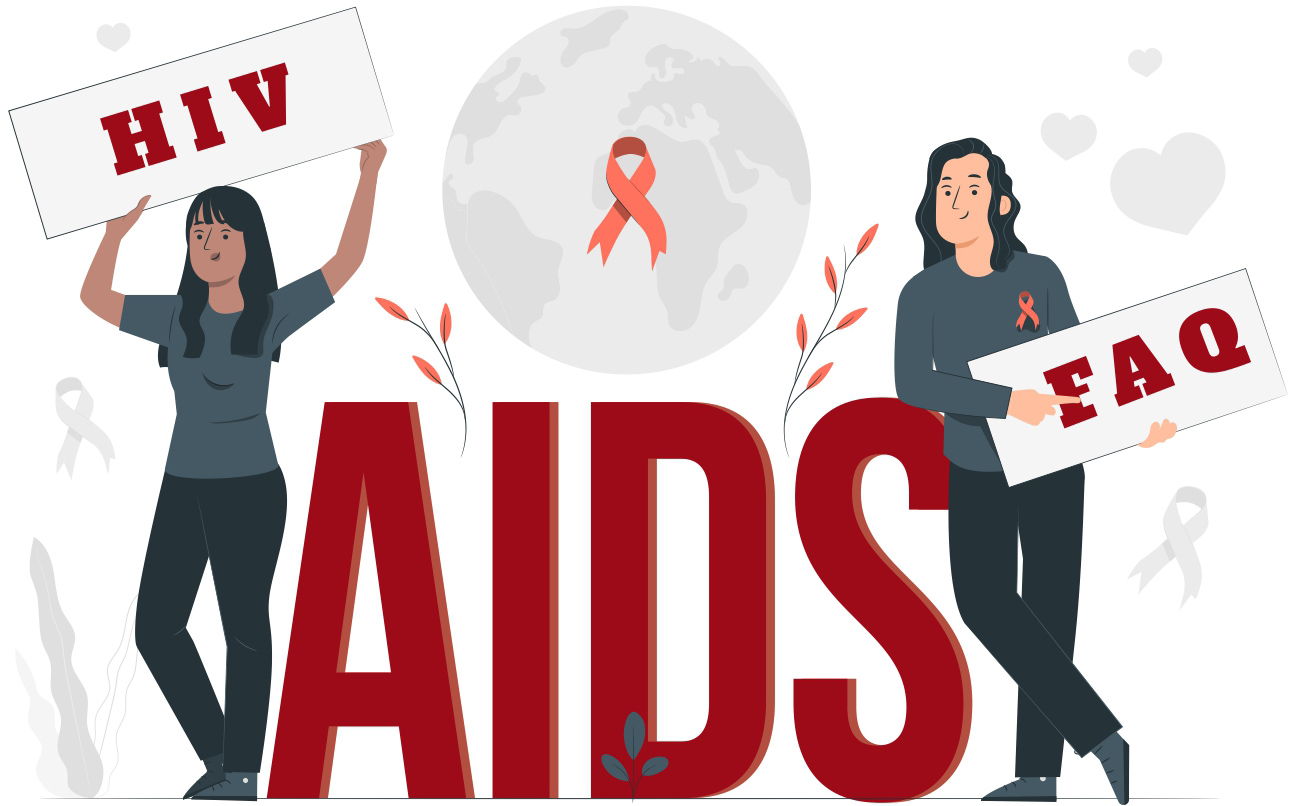
HIV (human immunodeficiency virus) is a virus that attacks cells that help the body fight infection, making a person more vulnerable to other infections and diseases. It is spread by contact with certain bodily fluids of a person with HIV, most commonly during unprotected sex (sex without a condom or HIV medicine to prevent or treat HIV), or through sharing injection drug equipment.




HIV stands for human immunodeficiency virus, which is the virus that causes HIV infection. AIDS stands for acquired immunodeficiency syndrome. AIDS is the most advanced stage of HIV infection.
HIV attacks and destroys the infection-fighting CD4 cells (CD4 T lymphocyte) of the immune system. The loss of CD4 cells makes it difficult for the body to fight off infections, illnesses, and certain cancers. Without treatment, HIV can gradually destroy the immune system, causing health decline and the onset of AIDS. With treatment, the immune system can recover.
HIV can be transmitted from one person to another when certain bodily fluids are shared between people. Bodily fluids that can transmit HIV include blood, semen, vaginal fluids, rectal fluids, and breast milk.
HIV can be transmitted during vaginal or anal sex, through sharing needles for injecting drugs or tattooing, by getting stuck with a needle that has the blood of someone with HIV on it, through pregnancy, and through breastfeeding.The transmission of HIV from a birthing parent with HIV to their child during pregnancy, childbirth, or breastfeeding is called perinatal transmission of HIV.
You cannot get HIV by shaking hands or hugging a person who has HIV. You also cannot get HIV from contact with objects, such as dishes, toilet seats, or doorknobs, used by a person with HIV. HIV is not spread through the air or water or by mosquitoes, ticks, or other insects.
Within 2 to 4 weeks after infection with HIV, some people may have flu-like symptoms, such as fever, chills, or rash. The symptoms may last for a few days to several weeks. Other possible symptoms of HIV include night sweats, muscle pain, sore throat, extreme tiredness, swollen lymph nodes, and mouth ulcers. Having these symptoms does not mean you have HIV. Other illnesses can cause the same symptoms. Some people may not feel sick during early HIV infection (called acute HIV). During this earliest stage of HIV infection, the virus multiplies rapidly. After the initial stage of infection, HIV continues to multiply but at lower levels.
More severe symptoms of HIV infection for persons not on ART may not appear for many years until HIV has developed into AIDS. People with AIDS have weakened immune systems that make them prone to opportunistic infections. Opportunistic infections are infections and infection-related cancers that occur more frequently or are more severe in people with weakened immune systems than in people with healthy immune systems.
Without treatment, HIV transmission is possible at any stage of HIV infection—even if a person with HIV has no symptoms of HIV.
Symptoms such as fever, weakness, and weight loss may be a sign that a person’s HIV has advanced to AIDS. HIV can be diagnosed through blood or saliva testing. Tests include:
Antigen-antibody tests: These tests most often use blood from a vein. Antigens are substances on the HIV virus itself. They most often show up in the blood within a few weeks after being exposed to HIV. The immune system makes antibodies when it's exposed to HIV. It can take weeks to months for antibodies to show up in blood. You may not show a positive result on an antigen-antibody test until 2 to 6 weeks after exposure to HIV.
Antibody tests: These tests look for antibodies to HIV in blood or saliva. Most rapid HIV tests are antibody tests. This includes self-tests done at home. You may not show a positive result on an antibody test until 3 to 12 weeks after you've been exposed to HIV.
Nucleic acid tests (NATs): These tests look for the virus in the blood, called viral load. They use blood from a vein.
If someone have been exposed to HIV within the past few weeks, health care professional may suggest NAT. NAT is the first test to become positive after exposure to HIV.
If any of these tests are negative, person may need a follow-up test weeks to months later to confirm the results.
If the person has been diagnosed with HIV/AIDS, following tests can help the healthcare professional to learn the stage of the disease and the best treatment.
CD4 T cell count: CD4 T cells are white blood cells that HIV targets and destroys. Even if you have no symptoms, HIV infection becomes AIDS when your CD4 T cell count dips below 200.
Viral load also called HIV RNA: This test measures the amount of virus in your blood. After starting HIV treatment, the goal is to have a viral load so low that it doesn't show up on the test, called undetectable. This greatly reduces your chances of opportunistic infection and other HIV-related complications.
Medicine resistance: Some category of HIV virus are resistant to medicines. This test helps the healthcare professional to know if the HIV patient has the form of the virus that has produced resistance. This guides treatment decisions.
There's no cure for HIV/AIDS. Once the person is infected with HIV virus, the body can't get rid of it. But there are medicines that can control HIV and prevent complications. Antiretroviral therapy (ART) is the use of HIV medicines to treat HIV infection. People on ART take a combination of HIV medicines (called an HIV treatment regimen) every day (pills) or by schedule (injections). In many cases oral medicines may be combined into a single pill or capsule. There are newer long-acting medicines given by an injection every 2 months that may be used in some people.
ART is recommended for everyone who has HIV. ART prevents HIV from multiplying, which reduces the amount of HIV in the body (called the viral load). Having less HIV in the body protects the immune system and prevents HIV infection from advancing to AIDS. ART cannot cure HIV, but HIV medicines can help people with HIV live long, healthy lives.
ART reduces the risk of HIV transmission. ART can reduce a person’s viral load to an undetectable level. An undetectable viral load means that the level of HIV in the blood is too low to be detected by a viral load test. People with HIV who maintain an undetectable viral load have no risk of transmitting HIV to their HIV-negative partner through sex.
HIV medicines taken during pregnancy, childbirth, and breastfeeding can also reduce the risk of perinatal (parent to infant) transmission of HIV. Pregnant people with HIV can speak with their health care provider to determine what method of feeding their baby is right for them.
For people without HIV, there are several ways to reduce the risk of acquiring HIV infection. Using condoms correctly with every sexual encounter, particularly with partners that are HIV positive with a detectable viral load or with partners whose HIV status is unknown, can reduce the risk of acquiring HIV. Reducing HIV risk also involves limiting and reducing sexual partners, and avoiding sharing needles.
Pre-exposure prophylaxis (PrEP) is an HIV prevention option for people who do not have HIV but who are at risk of becoming infected with HIV. PrEP involves taking a specific HIV medicine every day or a long-acting injection.
Lorem ipsum dolor sit amet, consetetur sadipscing elitr, sed diam nonumy eirmod tempor invidunt ut labore et dolore magna aliquyam erat, sed diam voluptua. At veroeos et accusam et justo duo dolores et ea rebum. Stet clita kasd gubergren, no sea takimata sanctus est Lorem ipsum… Lorem ipsum dolor sit amet, consetetur sadipscing elitr, sed diam nonumy eirmod tempor invidunt ut labore et dolore magna aliquyam erat, sed diam voluptua. At vero eos et accusam et justo duo dolores et ea rebum. Stet clita kasd gubergren, no sea takimata sanctus est Lorem ipsum…

Lorem ipsum dolor sit amet, consetetur sadipscing elitr, sed diam nonumy eirmod tempor invidunt ut labore et dolore magna aliquyam erat, sed diam voluptua. At veroeos et accusam et justo duo dolores et ea rebum. Stet clita kasd gubergren, no sea takimata sanctus est Lorem ipsum… Lorem ipsum dolor sit amet, consetetur sadipscing elitr, sed diam nonumy eirmod tempor invidunt ut labore et dolore magna aliquyam erat, sed diam voluptua. At vero eos et accusam et justo duo dolores et ea rebum. Stet clita kasd gubergren, no sea takimata sanctus est Lorem ipsum…

Lorem ipsum dolor sit amet, consetetur sadipscing elitr, sed diam nonumy eirmod tempor invidunt ut labore et dolore magna aliquyam erat, sed diam voluptua. At veroeos et accusam et justo duo dolores et ea rebum. Stet clita kasd gubergren, no sea takimata sanctus est Lorem ipsum… Lorem ipsum dolor sit amet, consetetur sadipscing elitr, sed diam nonumy eirmod tempor invidunt ut labore et dolore magna aliquyam erat, sed diam voluptua. At vero eos et accusam et justo duo dolores et ea rebum. Stet clita kasd gubergren, no sea takimata sanctus est Lorem ipsum…
